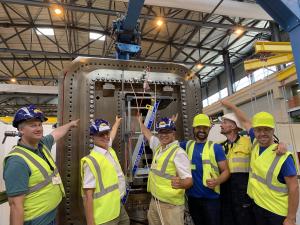The high-performance vacuum sealing of the ITER vacuum vessel's 50+ large ports is a "first of a kind" challenge due to the rectangular shape of the ports, their large size, and the need to remove and replace port plugs (large, stainless-steel components that "plug" the openings and also play a role as structural host to systems such as diagnostics).
Eamonn Quinn is responsible officer for the Large Seal Test Rig (LSTR) program. "To leave nothing to chance, a full-size replica of the largest equatorial ports was designed, manufactured and installed on site with the purpose of testing the vacuum sealing of what will be the largest ports ever built on a tokamak."
The equipment was installed in the European Poloidal Field Coils Winding Facility on site, where the "clean" conditions were ideal for the tests, and space was made available courtesy of the European Domestic Agency.
The test rig is of an impressive size (nearly 5 metres in height and as many in length) and it weighs around 19 tonnes. It gives a preview of how the ITER machine will look when seen through the equatorial ports cells, as they are starting now to take shape on the construction site. It was
built and installed by Indian high-tech company Vacuum Techniques.
There was much preparation, along with repeated inspections and some anxiety as the first large, double all-metallic seal was positioned on the flange. The flanges were brought together with the repeated tightening of 100 bolts, and after a number of hours of muscle flexing the seals were compressed.



